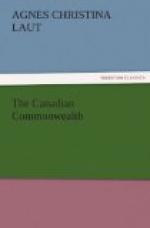far enough away from the episodes to state frankly
the facts that similar underground intrigue was at
work in both Red River and British Columbia, fostered,
much of it, by Irish malcontents of the old Fenian
raids. Once more Canada’s national consciousness
roused itself to a bigger problem and wider outlook.
Either the far-flung Canadian provinces must be bound
together in some sort of national unity or—the
Canadian mind did not let itself contemplate that
“or.” The provinces must be confederated
to be held. Hence confederation in 1867 under
the British North American Act, which is to Canada
what the Constitution is to the United States.
It happened that Sir John Macdonald, the future premier
of the Dominion, had been in Washington during one
period of the Civil War. He noted what he thought
was the great defect of the American system, and he
attributed the Civil War to that defect—namely,
that all powers not specifically delegated to the
federal government were supposed to rest with the
states. Therefore, when Canada formed her federation
of isolated provinces, Sir John and the other famous
Fathers of Confederation reversed the American system.
All power not specifically delegated to the provinces
was supposed to rest with the Dominion. Only
strictly local affairs were left with the provinces.
Trade, commerce, justice, lands, agriculture, labor,
marriage laws, waterways, harbors, railways were specifically
put under Dominion control.
IV
Now, stand back and contemplate the situation confronting
the new federation:
Canada’s population was less than half the present
population of the state of New York; not four million.
That population was scattered over an area the size
of Europe.[1] To render the situation doubly dark
and doubtful the United States had just entered on
her career of high tariff. That high tariff
barred Canadian produce out. There was only
one intermittent and unsatisfactory steamer service
across the Atlantic. There was none at all across
the Pacific. British Columbians trusted to windjammers
round the Horn. Of railroads binding East to
West there was none. A canal system had been
begun from the lakes and the Ottawa to the St. Lawrence,
but this was a measure more of national defense than
commerce. Crops were abundant, but where could
they be sold? I have heard relatives tell how
wheat in those days sold down to forty cents, and
oats to twenty cents, and potatoes to fifteen cents,
and fine cattle to forty dollars, and finest horses
to fifty dollars and seventy-five dollars. Fathers
of farmers who to-day clear their three thousand dollars
and four thousand dollars a year could not clear one
hundred dollars a year. Commerce was absolutely
stagnant. Canada was a federation, but a federation
of what? Poverty-stricken, isolated provinces.
Not in bravado, not in flamboyant self-confidence,
rebuffed of all chance to trade with the United States,




